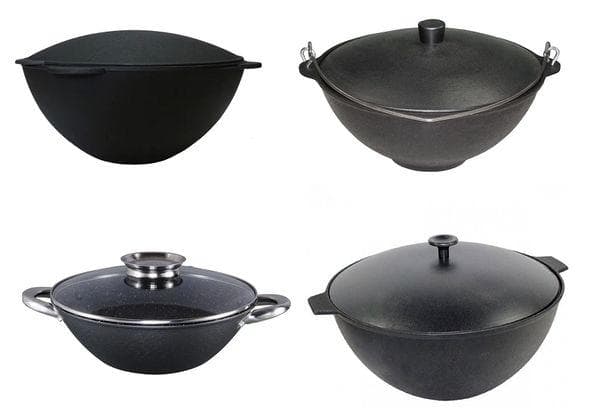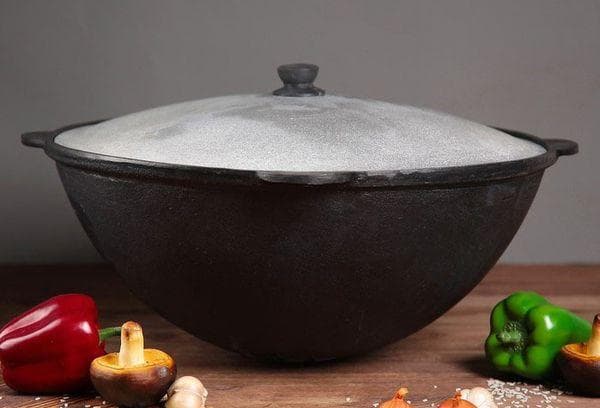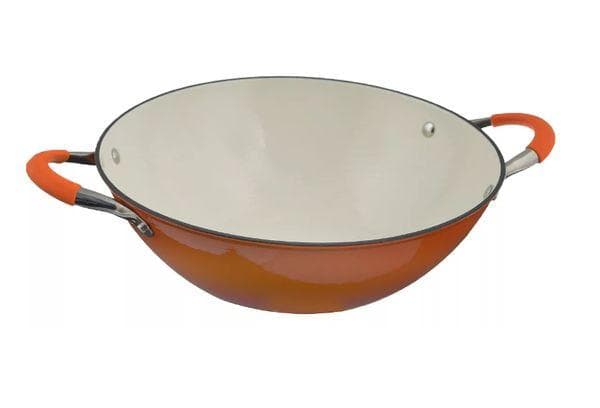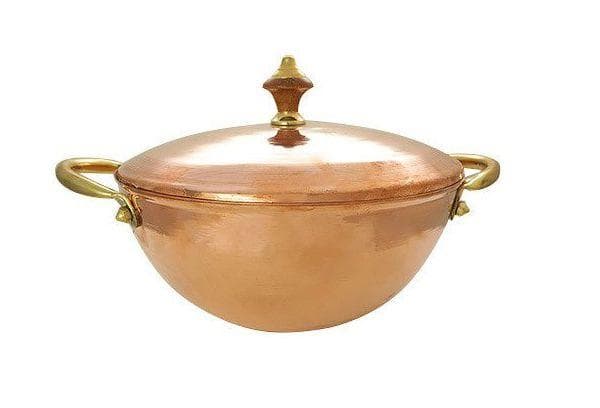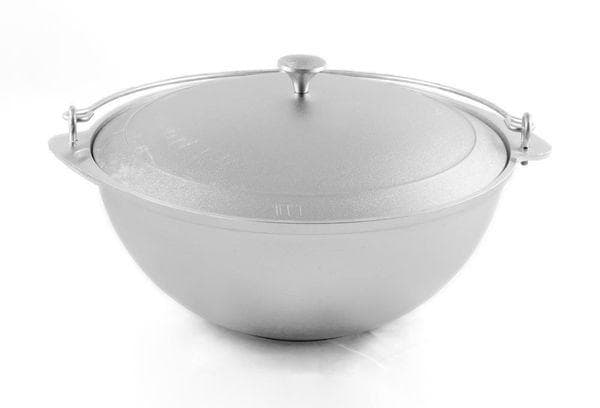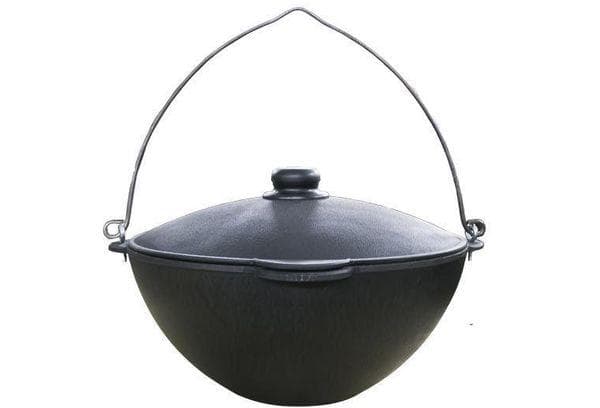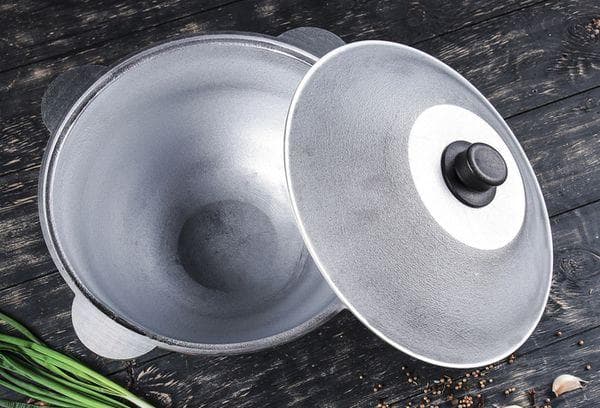Which cauldron is better to buy, cast iron or aluminum - which one to choose for pilaf and fire
Content:
Which cauldron is better - cast iron or aluminum - is a point of interest to lovers of Central Asian and Oriental cuisines. Using a cauldron, you can prepare a special dish that cannot be made in other dishes. Especially if the dish contains a variety of flavors. Let's talk about cauldrons: their features, characteristics, choice, care.
How a cauldron works, differences from a saucepan
Kazan is mainly used in Central Asian cuisine. In addition, thanks to the amazing design features, you can prepare a dish using completely different technologies. What is impossible to achieve from a saucepan.
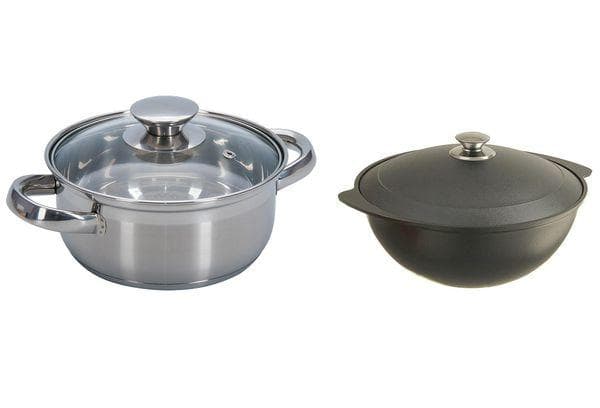
The body has a round shape. This is required so that heating is carried out evenly throughout the entire container. The form – it was not created this way by chance. After all, this cookware was originally intended for cooking over a fire. Thus, the tongues of fire seem to hug the dishes from all sides, trying to warm up every millimeter.
It is not surprising that many tourists, hunters and fishermen believe that a cauldron is one of the irreplaceable things that should always be with you. However, it is suitable not only for those who like to relax in the fresh air. This option is perfect for lovers of rich and incredible tastes. The dish turns out surprisingly aromatic and tasty.
Among the distinctive features are:
- The bottom can be round or hemispherical in shape. The pan is flat.
- Quite impressive weight, which other dishes do not have.
- Quite thick walls and bottom.
- The volume directly depends on the purchased model and purpose. However, models with a volume of up to 3 liters are practically not used.
- The cooked dish cools very slowly.
Kazan has an ancient and rich history. Despite the fact that a wide range of kitchen utensils can be found on sale today, they are still popular all over the world. Not only the pot, but also the contents inside it are heated evenly. However, it is worth noting that pans are used much more often for cooking.
Varieties
The existing variety of kitchen utensils allows us to satisfy the wishes and demands of any consumer. Including a favorite gourmet. On sale you can find models equipped with two handles. There are also models with three handles at once, which allows you to hang the pot over an open fire. However, that's not all. There are differences in volume, material used in production, and shapes.
Bottom shape, volume
If we consider a traditional cauldron, then in appearance it resembles a hemisphere. This form is one of the most convenient. Especially if you cook food on the go.Due to the presence of a convex day, the container heats up evenly. Actually, like the content itself.
Relatively recently, manufacturers began to sell cauldrons that are intended for home use. That is, you can cook food on a gas stove. The bottom of such models is flat. Which is convenient enough for home use.
If we consider tableware by volume, then there is a wide range of products on sale. Including the smallest ones - up to 2 liters. You can also choose a very impressive one - from 20 liters. The choice directly depends on the number of people for whom you plan to cook. And also on the purpose of the dishes. For example, if the company is small and consists of 2 people, then a 2-3 liter boiler will do. For a large family, it is better to choose 5 liters. It's possible even more. A lot depends on me.
To choose the appropriate option, it is recommended to adhere to the following rules:
- For 1 person – 1.5-2 liters.
- For 2-3 people – 5 liters.
- For 5-6 people – 8 liters.
- For a large company of 10 people or more – 15-20 liters.
As practice shows, the most delicious and rich pilaf is obtained in fairly large cauldrons.
Advice! If you plan to cook pilaf, then all ingredients should occupy 2/3 of the total volume of the container.
Lids, walls, handles
Most of the model is sold complete with a cover. As a rule, the same material is used for their production as for the main container. However, sometimes there may be covers made of wood or aluminum. In this case, the cauldron itself can be cast iron. Thanks to this solution, the weight of the product is significantly reduced. As a result, it becomes much easier to use.
When choosing the appropriate option, it is recommended to pay attention to the lid. And to be more precise, how tightly it fits. The diameter of the lid and the top rim should perfectly complement each other. For example, if the cauldron is made of cast iron, then it is better to choose the model whose lid is made of a different material. This will reduce weight.
Containers intended for fires and home use may differ from each other in design features. For example, models produced for open fire almost always have a stationary handle on top. It will be convenient to hang the container from it. The remaining two containers can be used to grab the pot.
If we consider the home option, then there is no need for an additional top handle. What is much more important here are comfortable side handles that you can grab and not be afraid of getting burned.
It is also worth paying attention to the thickness of the walls. They should not be thicker than 3 mm. The maximum permissible limit is 6 mm. However, some manufacturers sell finished products whose wall thickness reaches 10 mm. This is not the best option. It's better not to use it. Since heating is carried out quite slowly, which makes the cooking process long.
Types of materials
In this case, special attention is paid to one important point - uniform heating of the container and its contents. This parameter has a significant impact not only on the speed and quality of the dish, but also on the taste. If we consider the traditional design, then cast iron is mainly used. However, today you can find other materials.
Today you can find on sale finished products made from the following materials:
- Teflon, enamel coating. Modern option. Such models have an attractive appearance, which is not at all related to quality. The decorative coating is quickly destroyed. What are the effects of high temperatures? Also, Teflon requires the use of special spatulas.
- Copper. Despite the fact that this material is not the most suitable for the production of cauldrons, it is still used in some countries. For example, in Uzbekistan, Azerbaijan. Copper heats up quite quickly. This is where the advantages end. The material is susceptible to corrosion. A hot dish cools down very quickly. In addition, copper cookware requires special care.
- Aluminum. Perhaps one of the most common materials. Many manufacturers use cast aluminum to produce cast iron. If we consider the quality and service life, then aluminum is in no way inferior to cast iron. Such products are great for both home use and open fire.
- Cast iron. The most popular material used for the production of cauldrons. Dishes made of cast iron are considered indestructible. It can last for many generations.
As you can see, the most suitable option is cast iron or aluminum. Although other materials are also used, they are quite impractical and have a short service life.
Which cauldron is better: cast iron or aluminum?
If you compare how cast iron cookware differs from aluminum cookware, you should take into account the level of thermal conductivity, strength, resistance to high temperatures, resistance to mechanical damage, deformation, and oxidation. The mass of the finished product is also of particular importance. Here it is quite obvious that if you take products of the same size, then cast iron products will turn out to be much heavier.
| pros | Minuses | Price, rub.) | |
| Cast iron | Low thermal conductivity
It gets better over the years High temperature resistance Heats evenly Cools down slowly |
Heavy weight
Fragility High price The appearance of corrosion Requires special care |
from 2500 |
| Aluminum | Light weight
Attractive view Affordable price Easy to care for |
Cools down quickly
Deformed |
from 1000 |
Advantages and disadvantages of cast iron cauldrons
As you know, cast iron products are famous all over the world for their high level of quality when considered from a gastronomic point of view. The material is porous in structure. As a result, a natural non-stick layer is formed. It is this that improves the taste of the finished dish. Among other advantages, the following important points can be highlighted:
- Low level of thermal conductivity. Thanks to this, the cooked dish cools quite slowly. During the cooking process, products, like the walls of the dishes, are heated evenly. If the kit comes with a lid that fits quite tightly, then steam will take part during cooking.
- Over the years, cast iron cookware not only does not lose its characteristics and qualities, but only gets better. Since the structure is porous, over time fat begins to clog into it.It becomes clogged under the influence of high temperatures. As a result, a natural non-stick layer appears.
- Cast iron is not afraid of high temperatures and mechanical damage.
Despite the number of advantages, there are also some disadvantages. Among the disadvantages, the following points can be noted:
- An impressive mass. If we consider a pot with a capacity of about 15 liters, inside of which there is a ready-made dish, then lifting it will be extremely problematic. If you also add a lid made of the same material, then the dishes immediately become impractical for constant use.
- Fragility. Despite the fact that the material is not afraid of high temperatures, it is sensitive to temperature changes. In addition, if the container falls on a sharp surface, it will certainly break.
- Susceptibility to corrosion. If the cookware is not properly cared for, traces of rust will begin to appear over time, making the product completely unsuitable for further use.
- Price. As practice shows, cast iron products are the most expensive when compared with other materials.
It is also worth noting the unaesthetic appearance, which is critical for many housewives.
Advantages and disadvantages of aluminum cauldrons
The appearance of the aluminum pot resembles a regular saucepan. However, the walls are much thicker. If we consider the advantages, the first thing to note is the low weight, as well as an attractive appearance - which is not the case with cast iron products. In addition, aluminum products are much more affordable in cost.Together, all these qualities make the dishes accessible for use, especially for fishermen, hunters, and travelers.
Among the disadvantages are:
- High level of thermal conductivity. This material not only heats up quickly, but also cools down. As a result, the technology for preparing many dishes is violated. For example, this option is not recommended for pilaf.
- Tendency to deformation. Aluminum holds its shape very poorly, as a result of which it often changes, which is not good.
Another advantage is that aluminum is easy to care for. Before use, just rinse it with clean water. But with cast iron everything is much more complicated.
Which cauldron is best for pilaf
It is important for fans of Central Asian cuisine to choose a cauldron in which they can cook real tasty pilaf, in the best Uzbek traditions. And as you know, the finished dish will turn out much tastier in a cauldron. You can cook pilaf in a pan, but such a dish will definitely not become real pilaf. That is why it is recommended to use cast iron pots to prepare pilaf. Since it has all the necessary qualities:
- There is no non-stick coating on the inner surface - over time it becomes natural.
- The walls are parallel to each other. The dishes have a spherical shape.
- For convenient use at home, there are two handles.
- A tight-fitting lid, as a result of which steam takes part in the preparation of the dish.
There is an opinion that the best cauldrons are made in Tajikistan and Turkmenistan. Since special markings are applied to the product, it is not difficult to understand who exactly the manufacturer is.
How to care for cauldrons
In order for the dishes to retain their quality for as long as possible, they need to be properly cared for. If this is a pot made of cast iron, then the first thing you need to do is wash it, rinse it with warm water, wipe it, add salt and put it on the fire. Once the salt turns brown, you can remove it from the heat.
After use, the dishes are freed from food residues, rinsed, and wiped dry with a clean rag. Then the container is filled with water and placed on the fire until it boils. Then drain the water, rinse and wipe. The use of detergents is not recommended.
Now you can easily understand whether a cast iron or aluminum cauldron is better. However, it is impossible to give a definite answer. For use on an open fire, the aluminum version is better - it is lighter than cast iron and will be easier to carry. But for the home it is better to choose cast iron.
